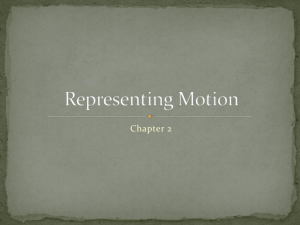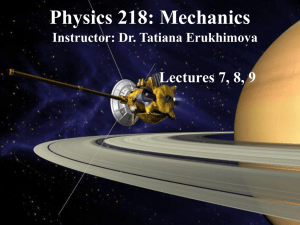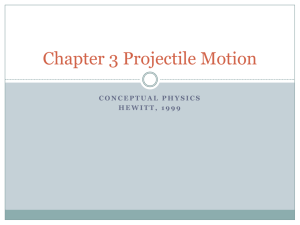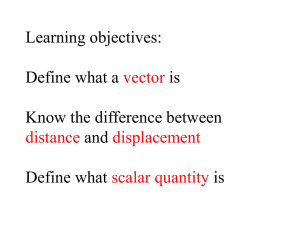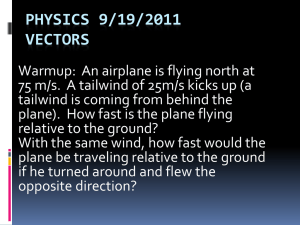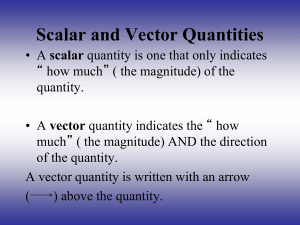Math review - ESM School District
advertisement
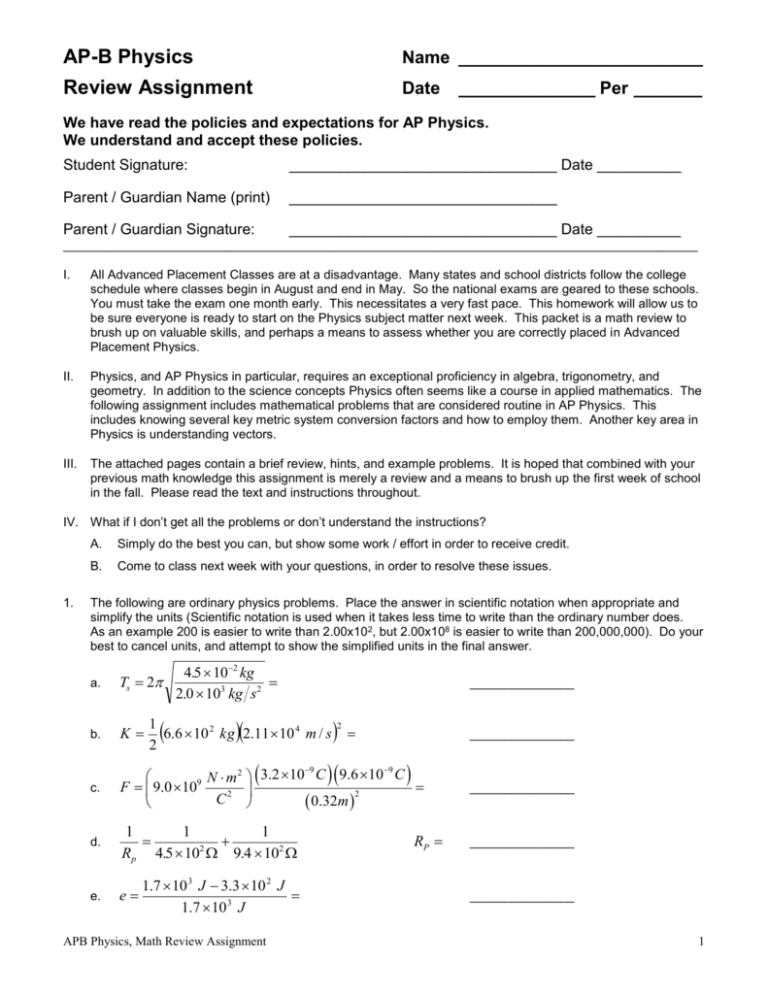
AP-B Physics Name _________________________ Review Assignment Date ______________ Per _______ We have read the policies and expectations for AP Physics. We understand and accept these policies. Student Signature: ________________________________ Date __________ Parent / Guardian Name (print) ________________________________ Parent / Guardian Signature: ________________________________ Date __________ ___________________________________________________________________________________________ I. All Advanced Placement Classes are at a disadvantage. Many states and school districts follow the college schedule where classes begin in August and end in May. So the national exams are geared to these schools. You must take the exam one month early. This necessitates a very fast pace. This homework will allow us to be sure everyone is ready to start on the Physics subject matter next week. This packet is a math review to brush up on valuable skills, and perhaps a means to assess whether you are correctly placed in Advanced Placement Physics. II. Physics, and AP Physics in particular, requires an exceptional proficiency in algebra, trigonometry, and geometry. In addition to the science concepts Physics often seems like a course in applied mathematics. The following assignment includes mathematical problems that are considered routine in AP Physics. This includes knowing several key metric system conversion factors and how to employ them. Another key area in Physics is understanding vectors. III. The attached pages contain a brief review, hints, and example problems. It is hoped that combined with your previous math knowledge this assignment is merely a review and a means to brush up the first week of school in the fall. Please read the text and instructions throughout. IV. What if I don’t get all the problems or don’t understand the instructions? 1. A. Simply do the best you can, but show some work / effort in order to receive credit. B. Come to class next week with your questions, in order to resolve these issues. The following are ordinary physics problems. Place the answer in scientific notation when appropriate and simplify the units (Scientific notation is used when it takes less time to write than the ordinary number does. As an example 200 is easier to write than 2.00x102, but 2.00x108 is easier to write than 200,000,000). Do your best to cancel units, and attempt to show the simplified units in the final answer. 4.5 102 kg 2.0 103 kg s2 a. Ts 2 b. K c. 2 3.2 109 C 9.6 109 C 9 N m F 9.0 10 2 C2 0.32m _______________ d. 1 1 1 2 Rp 4.5 10 9.4 102 _______________ e. e _______________ 1 6.6 10 2 kg 2.11 10 4 m / s 2 1.7 10 3 J 3.3 10 2 J 1.7 10 3 J APB Physics, Math Review Assignment 2 _______________ RP _______________ 1 2. f. 1.33 sin 25.0 1.50 sin g. K max 6.63 1034 J s 7.09 1014 s 2.17 1019 J _______________ h. _______________ 1 2.25 108 m s 1 3.00 108 m s _______________ Often problems on the AP exam are done with variables only. Solve for the variable indicated. Don’t let the different letters confuse you. Manipulate them algebraically as though they were numbers. a. v 2 vo 2as so , a _______________ b. K 2 1 2 kx 2 B h. xm i. pV nRT , T _______________ j. sin c n1 n2 , c _______________ , x _______________ g o I 2 r g. m L d c. Tp 2 d. mm Fg G 1 2 2 r , r _______________ e. mgh 1 2 mv 2 , v _______________ k. qV f. 1 x xo vot at 2 2 , t _______________ l. 1 1 1 f so si , g _______________ APB Physics, Math Review Assignment 1 2 mv 2 ,r _______________ ,d _______________ ,v _______________ , si _______________ 2 3. Science uses the KMS system (SI: System Internationale). KMS stands for kilogram, meter, second. These are the units of choice of physics. The equations in physics depend on unit agreement. So you must convert to KMS in most problems to arrive at the correct answer. kilometers (km) to meters (m) and meters to kilometers gram (g) to kilogram (kg) centimeters (cm) to meters (m) and meters to centimeters Celsius (oC) to Kelvin (K) millimeters (mm) to meters (m) and meters to millimeters nanometers (nm) to meters (m) and metes to nanometers atmospheres (atm) to Pascals (Pa) liters (L) to cubic meters (m3) micrometers (m) to meters (m) Other conversions will be taught as they become necessary. What if you don’t know the conversion factors? Colleges want students who can find their own information (so do employers). Hint: Try a good dictionary and look under “measure” or “measurement”. Or the Internet? Enjoy. 6. a. 4008 g = _______________ kg h. 25.0 m = _______________ m b. 1.2 km = _______________ m i. 2.65 mm = _______________ m c. 823 nm = _______________ m j. 8.23 m = _______________ km k. 5.4 L = _______________ m3 l. 40.0 cm = _______________ m m. 6.23x10-7 n. 1.5x1011 m oC d. 298 K = _______________ e. 0.77 m = _______________ cm f. 8.8x10-8 g. 1.2 atm m = _______________ mm = _______________ Pa m = _______________ nm = _______________ km Solve the following geometric problems. a. Line B touches the circle at a single point. Line A extends through the center of the circle. i. What is line B in reference to the circle? B _______________ ii. How large is the angle between lines A and B? A _______________ b. What is angle C? C _______________ 30o 45o c. What is angle ? 30o _______________ d. How large is ? _______________ 30o APB Physics, Math Review Assignment 3 e. The radius of a circle is 5.5 cm, i. What is the circumference in meters? ii. f. _______________ What is its area in square meters? 4 _______________ What is the area under the curve at the right? _______________ 12 7. 20 Using the generic triangle to the right, Right Triangle Trigonometry and Pythagorean Theorem solve the following. Your calculator must be in degree mode. a. = 55o and c = 32 m, solve for a and b. d. a = 250 m and b = 180 m, solve for and c. b. _______________ = 45o and a = 15 m/s, solve for b and c. e. _______________ a =25 cm and c = 32 cm, solve for b and . c. _______________ b = 17.8 m and = 65o, solve for a and c. f. _______________ b =104 cm and c = 65 cm, solve for a and . _______________ _______________ Vectors Most of the quantities in physics are vectors. This makes proficiency in vectors extremely important. Magnitude: Size or extent. The numerical value. Direction: Alignment or orientation of any position with respect to any other position. Scalars: A physical quantity described by a single number and units. A quantity described by magnitude only. Examples: time, mass, and temperature Vector: A physical quantity with both a magnitude and a direction. A directional quantity. Examples: velocity, acceleration, force Notation: A or A Length of the arrow is proportional to the vectors magnitude. Direction the arrow points is the direction of the vector. Negative Vectors Negative vectors have the same magnitude as their positive counterpart. They are just pointing in the opposite direction. A A Vector Addition and subtraction Think of it as vector addition only. The result of adding vectors is called the resultant. A B R A + B = R R So if A has a magnitude of 3 and B has a magnitude of 2, then R has a magnitude of 3+2=5. When you need to subtract one vector from another think of the one being subtracted as being a negative vector. Then add them. APB Physics, Math Review Assignment 4 A B is really A B R A B + R = A negative vector has the same length as its positive counterpart, but its direction is reversed. So if A has a magnitude of 3 and B has a magnitude of 2, then R has a magnitude of 3+(-2)=1. This is very important. In physics a negative number does not always mean a smaller number. Mathematically –2 is smaller than +2, but in physics these numbers have the same magnitude (size), they just point in different directions (180o apart). There are two methods of adding vectors Parallelogram A+B A A A R B B B A–B A R A B -B Tip to Tail A+B -B B A B A B A A–B A R -B -B A B R A A It is readily apparent that both methods arrive at the exact same solution since either method is essentially a parallelogram. It is useful to understand both systems. In some problems one method is advantageous, while in other problems the alternative method is superior. 8. 9. Draw the resultant vector using the parallelogram method of vector addition. Example b. d. a. e. c. Draw the resultant vector using the tip to tail method of vector addition. Label the resultant as vector R Example 1: A + B a. X + Y B Y X B A A R -B Example 2: A – B A B b. A APB Physics, Math Review Assignment R T–S T S 5 c. P+V e. P A+B+C B A C V C–D d. C A–B–C f. D B A C Direction: What does positive or negative direction mean? How is it referenced? The answer is the coordinate axis system. In physics a coordinate axis system is used to give a problem a frame of reference. Positive direction is a vector moving in the positive x or positive y direction, while a negative vector moves in the negative x or negative y direction (This also applies to the z direction, which will be used sparingly in this course). +y -x +x -y What about vectors that don’t fall on the axis? You must specify their direction using degrees measured from East. Component Vectors A resultant vector is a vector resulting from the sum of two or more other vectors. Mathematically the resultant has the same magnitude and direction as the total of the vectors that compose the resultant. Could a vector be described by two or more other vectors? Would they have the same total result? This is the reverse of finding the resultant. You are given the resultant and must find the component vectors on the coordinate axis that describe the resultant. R +Ry R +Rx R or +Ry +Rx Any vector can be described by an x axis vector and a y axis vector which summed together mean the exact same thing. The advantage is you can then use plus and minus signs for direction instead of the angle. 10. For the following vectors draw the component vectors along the x and y axis. a. b. APB Physics, Math Review Assignment 6 c. d. Obviously the quadrant that a vector is in determines the sign of the x and y component vectors. Trigonometry and Vectors Given a vector, you can now draw the x and y component vectors. The sum of vectors x and y describe the vector exactly. Again, any math done with the component vectors will be as valid as with the original vector. The advantage is that math on the x and/or y axis is greatly simplified since direction can be specified with plus and minus signs instead of degrees. But, how do you mathematically find the length of the component vectors? Use trigonometry. cos 10 10 y 40o adj hyp sin adj hyp cos opp hyp sin x hyp cos y hyp sin x 10 cos 40 x 7.66 o 40o opp hyp y 10 sin 40o y 6.43 x 11. Solve the following problems. You will be converting from a polar vector, where direction is specified in degrees measured counterclockwise from east, to component vectors along the x and y axis. Remember the plus and minus signs on you answers. They correspond with the quadrant the original vector is in. Hint: Draw the vector first to help you see the quadrant. Anticipate the sign on the x and y vectors. Do not bother to change the angle to less than 90o. Using the number given will result in the correct + and – signs. The first number will be the magnitude (length of the vector) and the second the degrees from east. Your calculator must be in degree mode. Example: 250 at 235o b. 6.50 at 345o x hyp cos 235 o x 250 cos 235o x 143 y hyp sin 250 y 250sin 235o y 205 a. 89 at 150o APB Physics, Math Review Assignment c. 0.00556 at 60o 7 d. 7.5x104 at 180o f. 990 at 320o e. 12 at 265o g. 8653 at 225o 12. Given two component vectors solve for the resultant vector. This is the opposite of number 11 above. Use Pythagorean Theorem to find the hypotenuse, then use inverse (arc) tangent to solve for the angle. Example: x = 20, y = -15 20 opp adj R2 x 2 y 2 tan R x2 y2 tan 1 R 202 152 tan 1 opp adj y x -15 R 25 360o 36.9o 323.1o a. x = 600, y = 400 c. x = -32, y = 16 b. x = -0.75, y = -1.25 d. x = 0.0065, y = -0.0090 APB Physics, Math Review Assignment 8 e. x = 20,000, y = 14,000 f. x = 325, y = 998 How are vectors used in Physics? They are used everywhere! Speed Speed is a scalar. It only has magnitude (numerical value). vs = 10 m/s means that an object is going 10 meters every second. But, we do not know where it is going. Velocity Velocity is a vector. It is composed of both magnitude and direction. Speed is a part (numerical value) of velocity. v = 10 m/s north, or v = 10 m/s in the +x direction, etc. There are three types of speed and three types of velocity Instantaneous speed / velocity: The speed or velocity at an instant in time. You look down at your speedometer and it says 20 m/s. You are traveling at 20 m/s at that instant. Your speed or velocity could be changing, but at that moment it is 20 m/s. Average speed / velocity: If you take a trip you might go slow part of the way and fast at other times. If you take the total distance traveled divided by the time traveled you get the average speed over the whole trip. If you looked at your speedometer from time to time you would have recorded a variety of instantaneous speeds. You could go 0 m/s in a gas station, or at a light. You could go 30 m/s on the highway, and only go 10 m/s on surface streets. But, while there are many instantaneous speeds there is only one average speed for the whole trip. Constant speed / velocity: If you have cruise control you might travel the whole time at one constant speed. If this is the case then you average speed will equal this constant speed. A trick question Will an object traveling at a constant speed of 10 m/s also always have constant velocity? Not always. If the object is turning around a curve or moving in a circle it can have a constant speed of 10 m/s, but since it is turning, its direction is changing. And if direction is changing then velocity must change, since velocity is made up of speed and direction. Constant velocity must have both constant magnitude and constant direction. Rate Speed and velocity are rates. A rate is a way to quantify anything that takes place during a time interval. Rates are easily recognized. They always have time in the denominator. 10 m/s 10 meters / second The very first Physics Equation Velocity and Speed both share the same equation. Remember speed is the numerical (magnitude) part of velocity. Velocity only differs from speed in that it specifies a direction. v x t v stands for velocity x stands for displacement t stands for time Displacement is a vector for distance traveled in a straight line. It goes with velocity. Distance is a scalar and goes with speed. Displacement is measured from the origin. It is a value of how far away from the origin you are at the end of the problem. The direction of a displacement is the shortest straight line from the location at the beginning of the problem to the location at the end of the problem. APB Physics, Math Review Assignment 9 How do distance and displacement differ? Supposes you walk 20 meters down the + x axis and turn around and walk 10 meters down the – x axis. The distance traveled does not depend on direction since it is a scalar, so you walked 20 + 10 = 30 meter. Displacement only cares about you distance from the origin at the end of the problem. +20 – 10 = 10 meter. 13. Attempt to solve the following problems. Take heed of the following. Always use the KMS system: Units must be in kilograms, meters, seconds. On the all tests, including the AP exam you must: 1. List the original equation used. 2. Show correct substitution. 3. Arrive at the correct answer with correct units. Distance and displacement are measured in meters (m) Speed and velocity are measured in meters per second (m/s) Time is measured in seconds (s) Example: A car travels 1000 meters in 10 seconds. What is its velocity? 1000m 10s v x t a. A car travels 35 km west and 75 km east. What distance did it travel? b. A car travels 35 km west and 75 km east. What is its displacement? c. A car travels 35 km west, 90 km north. What distance did it travel? d. A car travels 35 km west, 90 km north. What is its displacement? e. A bicyclist pedals at 10 m/s in 20 s. What distance was traveled? f. An airplane flies 250.0 km at 300 m/s. How long does this take? g. A skydiver falls 3 km in 15 s. How fast are they going? h. A car travels 35 km west, 90 km north in two hours. What is its average speed? i. A car travels 35 km west, 90 km north in two hours. What is its average velocity? v APB Physics, Math Review Assignment v 100 m s 10

